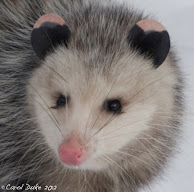
Common pokeweed can grow upwards to ten feet and is a native to eastern North America.

It must be confusing to the perennial plant to have so many names. It is known as Phytolacca decandra, Pokeberry, Pokeweed, Inkberry, American cancer, Cancer root, American nightshade, Virginia poke and more.

Beware, this is a very poisonous plant! Children and adults have been poisoned by eating the berries and leaves. The root is the most toxic part. Be careful when handling the stems and leaves.


Birds love the berries and most likely planted this one beneath an apple tree. It seems the plant is only poisonous to mammals. Cedar Waxwings flock to the plant and are feasting on the purple-black berries. You may recognize this photo from a recent Garden Walk Bloom Day. It illustrates the beauty and size of Pokeweed so well it gets another show.

Cedar Waxwings are picking the ripe berries, leaving behind tiny flower like calyxes.


Native Americans use the berries to make a red dye and use all parts of the plant for medicinal cures. You can see the sky and the photographer reflected in the shinny fruit.
If you look carefully, you can see the tiny flowers at the tip of the cluster and the berries beginning to form. In this photo one can observe the entire cycle from flower to mature berry.
Solidago sp or Goldenrod is an autumn perennial favorite for butterflies, bees and a variety of other insects. It is a greatly misunderstood plant, as it blooms at the same time as Ragweed, which causes allergic reactions. Ragweed is pollinated by the wind, whereas Goldenrod has fat heavy pollen that gets carried off by the bees and other insects. It is not the culprit that creates itchy eyes and hurtful sinuses.
The north field is aglow with yellow. Monarch butterflies are grateful for the sweet Goldenrod nectar. This female looks pretty fresh. I eyed her, while holding a newly emerged male out towards the gardens. He was not eager to take that first flight, so I took him out to join his cousin or perhaps sibling.
He will fly when he is ready and may take a sip from a few of the tiny florets of Goldenrod before he is off. It is Wildflower Wednesday over at gracious Gail's 'Clay and Limestone' . . . why not take a click over that way to see other wild blooms around the country.



































































































































